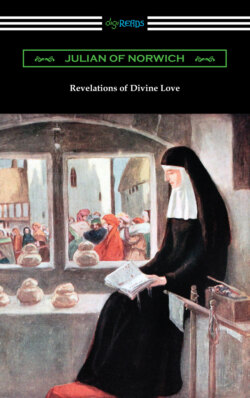Читать книгу Revelations of Divine Love - Julian of Norwich - Страница 6
NOTE AS TO THE LADY JULIAN, ANCHORESS AT ST JULIAN’S, AND THE LADY JULIAN LAMPET, ANCHORESS AT CARROW
ОглавлениеIN Carrow Abbey, by Walter Rye (privately printed, 1889), is given a list of Wills, in which the name of the Lady Julian Lampet frequently occurs as a legatee between the years 1427 (Will of Sir John Erpingham) and 1478 (Will of William Hallys). Comparing the Will of Hallys with that of Margaret Purdance, which was made in 1471 but not proved till 1483, and from which the name of Lady Julian Lampet as a legatee is stroked out, no doubt because of her death, we find evidence that this anchoress died between 1478 and 1483. As even the earlier of these dates was a hundred and thirty-six years after the birth of the writer of the “Revelations,” who in May 1373 was over thirty years of age, the identity of the “Lady Julian, recluse at Norwich,” with the Lady Julian Lampet, though it has naturally been suggested, is surely an impossibility. There were anchorages in the churchyards both of St Julian’s, Conisford (which belonged to the nuns of Carrow in the sense of its revenues having been made over to them by King Stephen for the support of that Priory or “Abbey “), and of St Mary’s, the Convent Church of the nuns. See the Will of Robert Pert—proved 1445—which left “to the anchoress of Carhowe z., to ditto at St Julian’s 1s.,” and that of the Lady Isobel Morley, who in 1466 left bequests to “Dame Julian, anchoress at Carrow, and Dame Agnes, anchoress at St Julian’s in Cunisford”—no doubt the same Dame Agnes that is mentioned by Blomefield as being at St Julian’s in 1472. This Agnes may have been the immediate successor of Julian the writer of the “Revelations,” who is spoken of as “yet in life”—as if in great age—in 1442, when she would be a hundred years old.
Perhaps the almost invariable use of the surname of the Carrow Dame Julian (who was, no doubt, of the family of Sir Ralph Lampet—frequently mentioned by Blomefield and in the Paston Letters) may go to establish proof that there had been before her and in her earlier years of recluse life another anchoress Julian, who most likely had been educated at Carrow, but who lived as an anchoress at St Julian’s, and was known simply as Dame or “the Lady” Julian.
From Blomefield’s History of Norfolk, vol. iv. p. 524: “Carhoe or Carrow stands on a hill by the side of the river, about a furlong from Conisford or Southgates, and was always in the liberty of the City [of Norwich]…. Here was an ancient Hospital or Nunnery, dedicated to Saint Mary and Saint John, to which King Stephen having given lands and meadows without the South-gate, Seyna and Lescelina, two of the sisters, in 1146 began the foundations of a new monastery called Kairo, Carrow, Car-hou, and sometimes Car-Dieu, which was dedicated to the Virgin Mary and Saint John, and consisted of a prioress and nine (afterwards twelve) Benedictine black nuns.... Their church was founded by King Stephen and was dedicated to the Blessed Virgin, and had a chapel of St John Baptist joined to its south side, and another of St Catherine to its north; there was also an anchorage by it, and in 1428 Lady Julian Lampet was anchoress there.” …“This nunnery for many years had been a school or place of education for the young ladies of the chief families of the diocese, who boarded with and were educated by the nuns.”
From Dr. Jessopp’s Visitations of the Diocese of Norwich, 14921532, Introduction, p. xliv.: “The priory of Carrow had always enjoyed a good reputation, and the house had for long been a favourite retreat for the daughters of the Norwich citizens who desired to give themselves to a life of religious retirement.”
